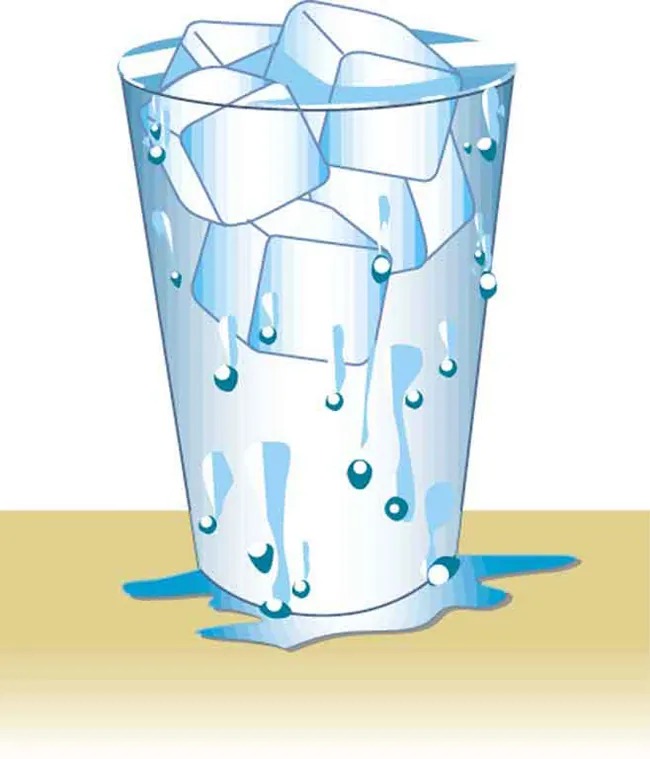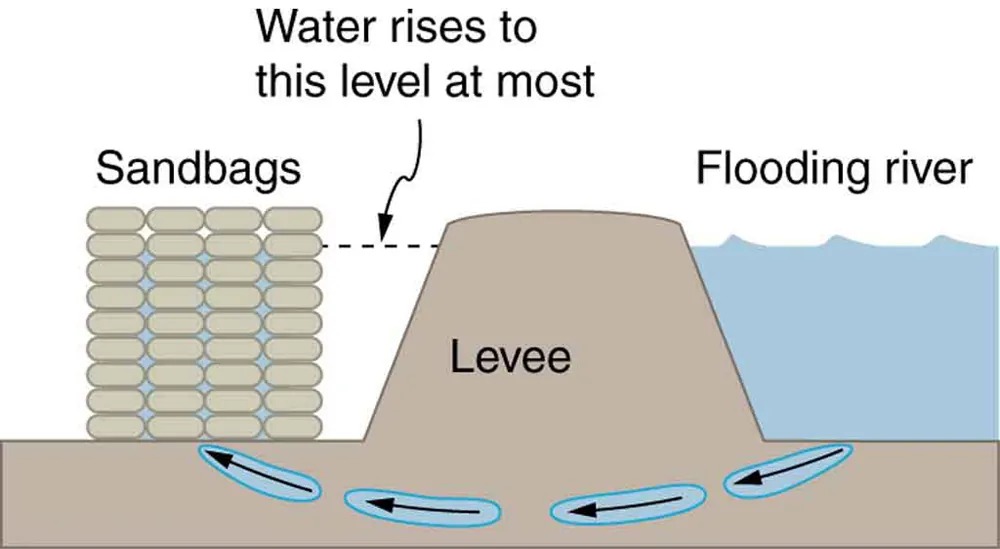Conceptual Questions
Conceptual Questions
9.1 What Is a Fluid?
- What physical characteristic distinguishes a fluid from a solid?
- Which of the following substances are fluids at room temperature: air, mercury, water, glass?
- Why are gases easier to compress than liquids and solids?
- How do gases differ from liquids?
9.2 Density
- Approximately how does the density of air vary with altitude?
- Give an example in which density is used to identify the substance composing an object. Would information in addition to average density be needed to identify the substances in an object composed of more than one material?
- Figure 9.37 shows a glass of ice water filled to the brim. Will the water overflow when the ice melts? Explain your answer.

Figure 9.37 Image from OpenStax College Physics 2e, CC-BY 4.0
9.3 Pressure
- How is pressure related to the sharpness of a knife and its ability to cut?
- Why does a dull hypodermic needle hurt more than a sharp one?
- The outward force on one end of an air tank was calculated in Example 9.2. How is this force balanced? (The tank does not accelerate, so the force must be balanced.)
- Why is force exerted by static fluids always perpendicular to a surface?
- In a remote location near the North Pole, an iceberg floats in a lake. Next to the lake (assume it is not frozen) sits a comparably sized glacier sitting on land. If both chunks of ice should melt due to rising global temperatures (and the melted ice all goes into the lake), which ice chunk would give the greatest increase in the level of the lake water, if any?
- How do jogging on soft ground and wearing padded shoes reduce the pressures to which the feet and legs are subjected?
- Toe dancing (as in ballet) is much harder on toes than normal dancing or walking. Explain in terms of pressure.
- How do you convert pressure units like millimeters of mercury, centimeters of water, and inches of mercury into units like newtons per meter squared without resorting to a table of pressure conversion factors?
9.4 Variation of Pressure with Depth in a Fluid
- Atmospheric pressure exerts a large force (equal to the weight of the atmosphere above your body—about 10 tons) on the top of your body when you are lying on the beach sunbathing. Why are you able to get up?
- Why does atmospheric pressure decrease more rapidly than linearly with altitude?
- What are two reasons why mercury rather than water is used in barometers?
- Figure 9.38 shows how sandbags placed around a leak outside a river levee can effectively stop the flow of water under the levee. Explain how the small amount of water inside the column formed by the sandbags is able to balance the much larger body of water behind the levee.

Figure 9.38 Because the river level is very high, it has started to leak under the levee. Sandbags are placed around the leak, and the water held by them rises until it is the same level as the river, at which point the water there stops rising. Image from OpenStax College Physics 2e, CC-BY 4.0
Image Description
The image is a diagram depicting a cross-section of a levee system designed to prevent flooding. On the left side, there are stacked sandbags labeled as “Sandbags.” To the right of the sandbags, there is an earthen structure labeled as “Levee,” which acts as a barrier between the land and a “Flooding river” depicted on the far right side. Above the levee, a dashed horizontal line with an arrow points downward, indicating “Water rises to this level at most,” showing the expected maximum water level. Below the surface, there are blue curved arrows illustrating the movement of water under the levee and sandbags, indicating potential seepage.
- Why is it difficult to swim under water in the Great Salt Lake?
- Is there a net force on a dam due to atmospheric pressure? Explain your answer.
- Does atmospheric pressure add to the gas pressure in a rigid tank? In a toy balloon? When, in general, does atmospheric pressure not affect the total pressure in a fluid?
- You can break a strong wine bottle by pounding a cork into it with your fist, but the cork must press directly against the liquid filling the bottle—there can be no air between the cork and liquid. Explain why the bottle breaks, and why it will not if there is air between the cork and liquid.
9.5 Pascal’s Principle
- Suppose the pedal cylinder in a hydraulic system is at a greater height than the wheel cylinder. Explain how this will affect the force produced at the wheel cylinder.
9.6 Gauge Pressure, Absolute Pressure, and Pressure Measurement
- Explain why the fluid reaches equal levels on either side of a manometer if both sides are open to the atmosphere, even if the tubes are of different diameters.
- Figure 9.15 shows how a common measurement of arterial blood pressure is made. Is there any effect on the measured pressure if the manometer is lowered? What is the effect of raising the arm above the shoulder? What is the effect of placing the cuff on the upper leg with the person standing? Explain your answers in terms of pressure created by the weight of a fluid.
- Considering the magnitude of typical arterial blood pressures, why are mercury rather than water manometers used for these measurements?
9.7 Archimedes’ Principle
- More force is required to pull the plug in a full bathtub than when it is empty. Does this contradict Archimedes’ principle? Explain your answer.
- Do fluids exert buoyant forces in a “weightless” environment, such as in the space shuttle? Explain your answer.
- Will the same ship float higher in salt water than in freshwater? Explain your answer.
- Marbles dropped into a partially filled bathtub sink to the bottom. Part of their weight is supported by buoyant force, yet the downward force on the bottom of the tub increases by exactly the weight of the marbles. Explain why.
9.8 Cohesion and Adhesion in Liquids: Surface Tension and Capillary Action
- The density of oil is less than that of water, yet a loaded oil tanker sits lower in the water than an empty one. Why?
- Is surface tension due to cohesive or adhesive forces, or both?
- Is capillary action due to cohesive or adhesive forces, or both?
- Birds such as ducks, geese, and swans have greater densities than water, yet they are able to sit on its surface. Explain this ability, noting that water does not wet their feathers and that they cannot sit on soapy water.
- Water beads up on an oily sunbather, but not on her neighbor, whose skin is not oiled. Explain in terms of cohesive and adhesive forces.
- Could capillary action be used to move fluids in a “weightless” environment, such as in an orbiting space probe?
- What effect does capillary action have on the reading of a manometer with uniform diameter? Explain your answer.
- Pressure between the inside chest wall and the outside of the lungs normally remains negative. Explain how pressure inside the lungs can become positive (to cause exhalation) without muscle action.

